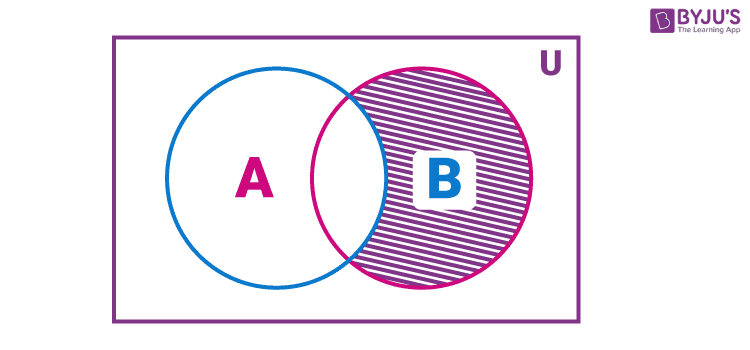We have learned how to perform addition, subtraction, multiplication, and division on numbers. We can apply each one of these operations on a pair of numbers to get another number. For example, when we subtract the pair of numbers 8 and 3, we get the number 5, i.e. the difference between 8 and 3 is 5. Likewise, there are certain operations that we can perform on two sets, which give rise to another set. In this article, you will learn one of the set operations, called the difference of sets, its definition, formulas and examples in detail.
Difference of Two Sets
The difference of the sets A and B in this order is the set of elements which belong to A but not to B. Symbolically, we write A – B and read as “ A minus B”.
The representation of A – B using a Venn diagram is given below.

Similarly, we can find B – A, the difference of the sets B and A in this order is the set of elements which belong to B but not to A. Symbolically, we write B – A and read as “ B minus A”. and a Venn diagram for B – A as:

Also, note that A – B is not equal to B – A, i.e. A – B ≠ B – A.
| Read more: |
Symmetric Difference between Two Sets
The set which contains the elements which are either in set A or in set B but not in both is called the symmetric difference between two given sets. It is represented by A ⊝ B and is read as a symmetric difference of set A and B.

Difference of Three Sets
It is possible to find the difference between three sets, say A, B and C.
Suppose A, B, and C are three non-empty sets, then A – B – C represents the set containing the elements of A that are not in B and C.
Venn diagram representation of A – B – C is given in the below diagram.

Some of the properties related to difference of sets are listed below:
- Suppose two sets A and B are equal then, A – B = A – A = ∅ (empty set) and B – A = B – B = ∅.
- The difference between a set and an empty set is the set itself, i.e, A – ∅ = A.
- The difference of a set from an empty set is an empty set, i.e, ∅ – A = ∅.
- The difference of a set, say A from universal set U is equal to empty set, i.e. A – U = ∅.
- When a superset is subtracted from a subset, then result is an empty set, i.e, A – B = ∅ if A ⊂ B
- If A and B are disjoint sets (no common elements for A and B), then A – B = A and B – A = B.
Let’s have a look at the solved examples given below to know how to calculate the difference of sets in case of two sets and three sets.
Difference of sets examples
Example 1:
If A = {1, 2, 3, 4, 5, 6} and B = {3, 4, 5, 6, 7, 8}, then find A – B and B – A.
Solution:
Given,
A = {1, 2, 3, 4, 5, 6}
B = {3, 4, 5, 6, 7, 8}
A – B = {1, 2} since the elements 1, 2 are there in A but not in B.
Similarly,
B – A = {7, 8}, since the elements 7 and 8 belong to B and not to A.
Also, we can show that A – B ≠ B – A.
Example 2:
If X = {11, 12, 13, 14, 15}, Y = {10, 12, 14, 16, 18} and Z = {7, 9, 11, 14, 18, 20}, then find the following:
(i) X – Y – Z
(ii) Y – X – Z
(iii) Z – X – Y
Solution:
Given,
X = {11, 12, 13, 14, 15}
Y = {10, 12, 14, 16, 18}
Z = {7, 9, 11, 14, 18, 20}
(i) X – Y – Z = {11, 12, 13, 14, 15} – {10, 12, 14, 16, 18} – {7, 9, 11, 14, 18, 20}
= {13, 15}
(ii) Y – X – Z = {10, 12, 14, 16, 18} – {11, 12, 13, 14, 15} – {7, 9, 11, 14, 18, 20}
= {10, 16}
(iii) Z – X – Y = {7, 9, 11, 14, 18, 20} – {11, 12, 13, 14, 15} – {10, 12, 14, 16, 18}
= {7, 9, 20}
Video Lesson on What are Sets

For more interesting maths concepts, download BYJU’S – The Learning App and learn all the maths and science concepts effectively and quickly.
Frequently Asked Questions on Difference of Sets
How do you find the difference of a set?
Suppose P and Q are two non-empty sets, then the difference of a set A from B, i.e. B – A can be found by identifying the elements in B which are not there in A.
What is A minus B in sets?
In set theory, the difference between A and B is the set A − B consists of elements that are in A but not in B.
What is the difference of a set to itself?
The set difference of a set to itself is equal to the empty set. That means, for any set A, A – A = ∅.
What are the different types of operations on sets?
The various operations we can perform on sets are:
Union of sets
Intersection of sets
Complement of a set
Difference of sets
Cartesian product of sets
Is A – B equal to B – A?
No, A – B is not equal to B – A in sets.
Comments